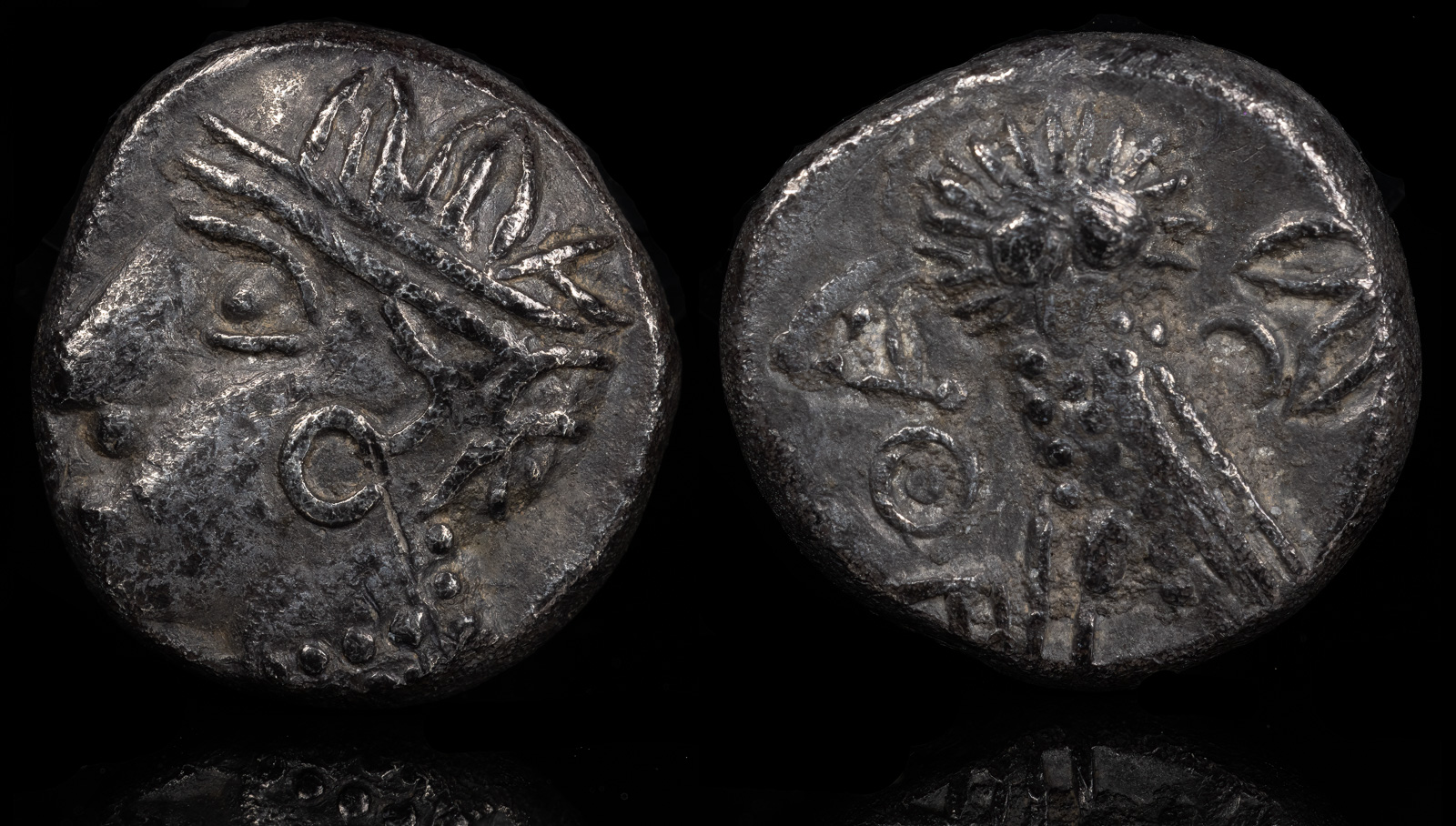
North Arabia
5th-3rd centuries BCE
15mm 4.0g
Helmeted head of Athena left / Owl standing left, head facing; olive spray to right.
Huth Qedar 1999 27-6
This coin has agonized me for some time. Recently, I found a similar example in a paper by Martin and Qedar where they write:
“Apart from these North Arabian coins and the abundant coinages in imitation of Athenian types from Palestine and South Arabia there are two more groups of Athenian imitations from the Arabian peninsula that can be placed in a chronological and economic context with the other coinages of the incense road. We know of four silver ‘drachms’ which share a certain similarity in style with the coin we described at the beginning of this paper. The first known piece of this group was illustrated by de Morgan (who had acquired it in Mascat) and subsequently by BMC Arabia (PL 27, 7). It, too, shows a ‘crest’ of annulets on Athena’s head, and the way in which the owl
is depicted with only a few dots and strokes is very similar. But this and the other three coins of this group are distinctly different in that the owl is rendered in incuse and bordered by inscriptions in an undeciphered script which is neither Aramaic nor South Arabian (PI. 27, 8-9). The technique of rendering an image partly in incuse was employed during the early period of the coinage of the Phoenician city-states during the fifth century BC. In view of the provenance of de Morgan’s specimen and the similarities with the coin reportedly found in southern Jordan, we attribute this group of Athenian imitations very tentatively to northern Arabia.”
Therefore, I’ll continue their tentative attribution to northern Arabia. For what it’s worth, here’s my original thought process behind the coin, before I discovered the Huth & Qedar paper.
The Edom attribution was what drew me to this coin. However, after some research, I doubted that the attribution was correct. Still, though, the coin was interesting. I have yet to find anything quite like it.
The following are the possibilities I’ve come up with.
Edom (Idumaea) – This is how the seller attributed it, but neither the obverse nor the reverse seems to match up. The owl is too “scruffy” and the image of Athena is too abstract. If I can’t find any better answer, I’ll enter it into the database as Idumaea, but I have little confidence.
Sabaeans – Those are mostly known from a less abstract Athena with an “N” on the cheek, so that appears to be a “no”.
Lihyan – The scruffy owls matches up, though mine is to the left while all the samples I found are to the right. Some of the later (2nd-1st centuries CE) copies do have an abstract Athena, though the match isn’t strong. Most of the copies have a particular monogram, which this lacks. My feeling is the coin may come from the vicinity of Lihyan, but attributing it to Lihyan would be incorrect.
Gaza – Adding this just to be comprehensive, but IMHO it’s clearly not Gaza since both the owl and Athena are too abstract and the cheek lacks the distinctive Gaza “M”.
Gaul/Celt – From what I can tell, they rarely imitated Athenian coinage. They seem to have been more likely to imitate that of Alexander and Philip, since those were the dominant coins when they entered the scene. The few mimics I found look nothing like this.
Philistia – I’ve found some copies that resemble this one. My belief is that “Philistia” is just a catch-all for “somewhere around the Levant”, but this coin still doesn’t match the style.
Time period – The seller attributed this to 400-300 BCE. The similar coins from CNG are dated to 5th century to 333 BCE. I tend to believe the CNG dates, as they’re broader and if this does come from the Levant then coinage would have ceased with Alexander. Some of the Arabian comps are dated to 2nd-1st centuries BCE, but this one seems to have an older style.
The interesting – Of the above searches, I couldn’t find a single comp where both Athena and the owl are to the left. Maybe that’s a sign that my attribution guesses are all completely off. To be honest, that’s what pushed me to go for this coin, as I wasn’t confident I’d ever have a chance at one like it – wherever it’s from.
So far, my belief is that this coin is Arabian from the 4th to the 2nd century BCE. It may have been minted in a very small release for some local warlord, since there is not yet a similar coin.
Relevant Resources
Alexander the Great sends an exploratory mission to the Arabian Peninsula while preparing for his campaign in Mesopotamia.
Alexander plans an expedition to Arabia to explore and possibly conquer parts of the peninsula, but dies before they leave.
Demetrios Poliorketes leads a campaign against the Nabataeans in Arabia, but is forced to withdraw.
Seleukos I Nikator founds the city of Charax Spasinu (near modern-day Basra, Iraq) as a port city to facilitate trade between Mesopotamia and Arabia.